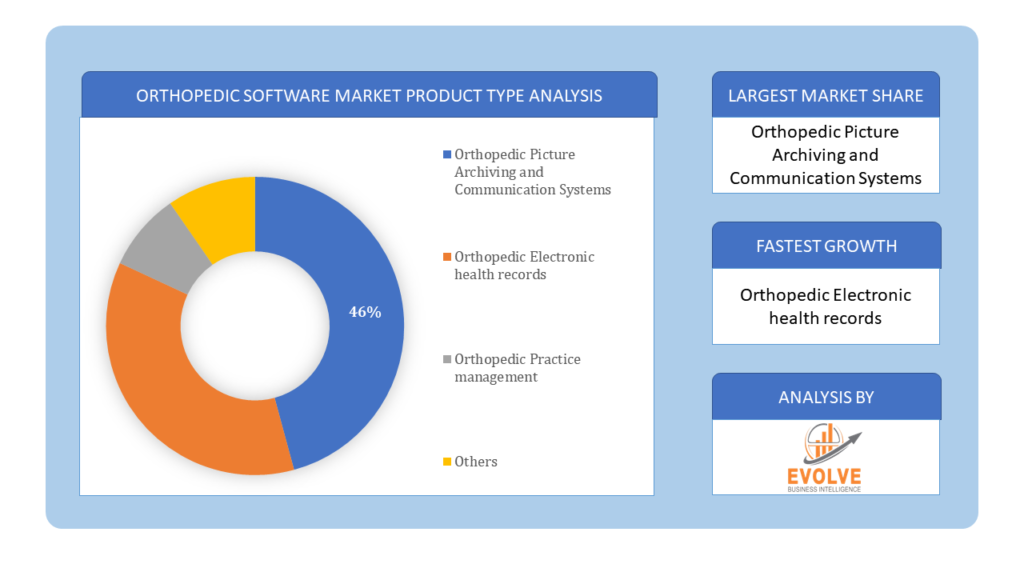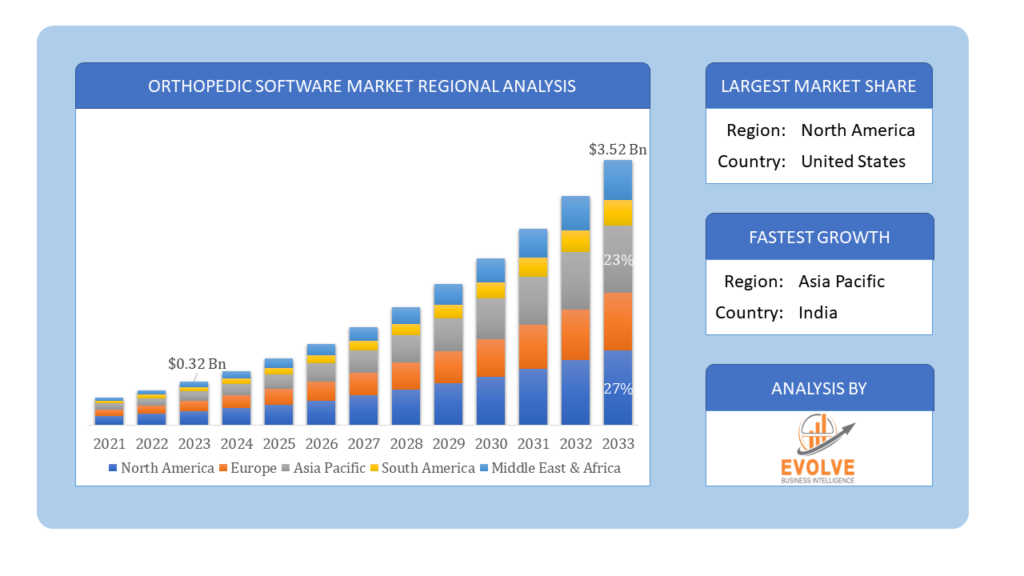Orthopedic Software Market Overview
The Orthopedic Software Market Size is expected to reach USD 3.52 Billion by 2033. The Orthopedic Software Market industry size accounted for USD 0.32 Billion in 2023 and is expected to expand at a compound annual growth rate (CAGR) of 8.47% from 2023 to 2033. The Orthopedic Software Market refers to the market for specialized software solutions designed for orthopedic practices and hospitals. This software aims to improve the efficiency and effectiveness of orthopedic care by providing tools for managing patient records, treatment plans, imaging, and workflows.
Key drivers for the Orthopedic Software Market include the increasing prevalence of orthopedic conditions, the rising demand for minimally invasive surgeries, advancements in medical technology, and the growing need for efficient and integrated healthcare IT solutions.
Global Orthopedic Software Market Synopsis
The COVID-19 pandemic had a significant impact on the Orthopedic Software Market. During the pandemic, there was a surge in the use of telemedicine to minimize patient visits to clinics and hospitals. This trend accelerated the adoption of orthopedic software that supports virtual consultations and remote patient monitoring, allowing for continued care while reducing the risk of infection. The pandemic highlighted the importance of digital transformation in healthcare. Orthopedic practices increasingly relied on digital solutions for electronic health records, practice management, and patient communication to maintain operations amidst restrictions. The need to manage resources efficiently during the pandemic led to greater interest in software solutions that optimize workflows and improve practice management, helping orthopedic practices streamline operations and manage patient care more effectively. The pandemic underscored the importance of data management and analytics in healthcare. Orthopedic software solutions that offer robust data analytics capabilities became more valuable, aiding in decision-making and resource allocation.
Orthopedic Software Market Dynamics
The major factors that have impacted the growth of Orthopedic Software Market are as follows:
Drivers:
Ø Advancements in Medical Technology
Technological advancements, such as artificial intelligence (AI), machine learning, and 3D imaging, are enhancing the capabilities of orthopedic software, making it more effective in diagnosis, treatment planning, and surgical interventions. As patients and healthcare providers increasingly prefer minimally invasive procedures due to their benefits, such as reduced recovery time and lower risk of complications, there is a greater need for software solutions that support these techniques, including preoperative planning and simulation tools. The shift toward patient-centered care is driving the adoption of software solutions that improve patient engagement, communication, and satisfaction. Orthopedic software that facilitates patient education and involvement in care decisions is gaining traction.
Restraint:
- Perception of High Implementation Costs and Data Privacy
The initial cost of acquiring and implementing orthopedic software solutions can be significant. This includes expenses related to software purchase, customization, training, and integration with existing systems, which can be a barrier for smaller practices or those with limited budgets. The handling of sensitive patient data involves strict regulatory requirements, such as the Health Insurance Portability and Accountability Act (HIPAA) in the U.S. Concerns about data breaches and compliance with data protection regulations can limit the adoption of new software solutions.
Opportunity:
⮚ Rising Demand for Digital Health Solutions
Increasing adoption of digital health solutions, including orthopedic software, driven by the need for efficient patient management, remote monitoring, and telehealth services. Shift towards value-based care models emphasizes outcomes and patient satisfaction, driving demand for orthopedic software that enhances patient engagement, education, and self-management tools. Opportunities exist for orthopedic software developers to improve interoperability with existing healthcare IT systems, ensuring seamless data exchange and integration across different care settings.
Orthopedic Software Market Segment Overview
By Product Type
 Based on Product Type, the market is segmented based on Orthopedic Picture Archiving and Communication Systems, Orthopedic Electronic health records, Orthopedic Practice management and Others. The Orthopedic EHR segment dominant the market. This is attributed due to increasing demand for data sharing and faster treatment process. Orthopedic Electronic Health Record (EHR) systems provide tailored solutions to meet the specific needs of orthopedic practices and clinics. These specialized software platforms streamline workflows, enhance efficiency, and improve patient care within orthopedic settings.
Based on Product Type, the market is segmented based on Orthopedic Picture Archiving and Communication Systems, Orthopedic Electronic health records, Orthopedic Practice management and Others. The Orthopedic EHR segment dominant the market. This is attributed due to increasing demand for data sharing and faster treatment process. Orthopedic Electronic Health Record (EHR) systems provide tailored solutions to meet the specific needs of orthopedic practices and clinics. These specialized software platforms streamline workflows, enhance efficiency, and improve patient care within orthopedic settings.
By Application
Based on Application, the market segment has been divided into the Joint Replacement, Fracture Management and Others. The joint replacement surgeries segment dominates the market. Joint replacement surgeries, including hip and knee replacements, are among the most common orthopedic procedures performed worldwide. These surgeries are often complex and require precise planning and execution to achieve optimal outcomes. Orthopedic software solutions designed for joint replacement surgeries offer advanced features such as preoperative planning, implant selection, and intraoperative navigation, which are essential for success.
Global Orthopedic Software Market Regional Analysis
Based on region, the global Orthopedic Software Market has been divided into North America, Europe, Asia-Pacific, the Middle East & Africa, and Latin America. North America is projected to dominate the use of the Orthopedic Software Market followed by the Asia-Pacific and Europe regions.
 Orthopedic Software North America Market
Orthopedic Software North America Market
North America holds a dominant position in the Orthopedic Software Market. North America is a hub for technological innovation in healthcare. The region leads in the development and adoption of artificial intelligence (AI), machine learning, and digital health solutions, which are increasingly integrated into orthopedic software for enhanced patient care and management.
Orthopedic Software Asia-Pacific Market
The Asia-Pacific region has indeed emerged as the fastest-growing market for the Orthopedic Software Market industry. China, Japan, and India are key markets due to large population base and rising healthcare investments. Rapid urbanization and improving healthcare infrastructure drive market expansion and growing adoption of telemedicine and digital health technologies presents opportunities for orthopedic software providers.
Competitive Landscape
The global Orthopedic Software Market is highly competitive, with numerous players offering a wide range of software solutions. The competitive landscape is characterized by the presence of established companies, as well as emerging startups and niche players. To increase their market position and attract a wide consumer base, the businesses are employing various strategies, such as product launches, and strategic alliances.
Prominent Players:
- Materialise NV
- Brainlab AG
- Medstrat Inc
- CureMD Healthcare
- Greenway Health
- NextGen Healthcare LLC
- McKesson Corporation
- GE Healthcare
- Philips Healthcare
- Merge Healthcare Incorporated
Scope of the Report
Global Orthopedic Software Market, by Product Type
- Orthopedic Picture Archiving and Communication Systems
- Orthopedic Electronic health records
- Orthopedic Practice management
- Others
Global Orthopedic Software Market, by Application
- Joint Replacement
- Fracture Management
- Others
Global Orthopedic Software Market, by Region
- North America
- US
- Canada
- Mexico
- Europe
- UK
- Germany
- France
- Italy
- Spain
- Benelux
- Nordic
- Rest of Europe
- Asia Pacific
- China
- Japan
- South Korea
- Indonesia
- Austalia
- Malaysia
- India
- Rest of Asia Pacific
- South America
- Brazil
- Argentina
- Rest of South America
- Middle East & Africa
- Saudi Arabia
- UAE
- Egypt
- South Africa
- Rest of Middle East & Africa
| Parameters | Indicators |
|---|---|
| Market Size | 2033: $3.52 Billion |
| CAGR | 8.47% CAGR (2023-2033) |
| Base year | 2022 |
| Forecast Period | 2023-2033 |
| Historical Data | 2021 |
| Report Coverage | Revenue Forecast, Competitive Landscape, Growth Factors, and Trends |
| Key Segmentations | Product Type, Application |
| Geographies Covered | North America, Europe, Asia-Pacific, Latin America, Middle East, Africa |
| Key Vendors | Materialise NV, Brainlab AG, Medstrat Inc, CureMD Healthcare, Greenway Health, NextGen Healthcare LLC, McKesson Corporation, GE Healthcare, Philips Healthcare and Merge Healthcare Incorporated |
| Key Market Opportunities | • Rising Demand for Digital Health Solutions • Focus on Value-Based Care and Patient Engagement |
| Key Market Drivers | • Advancements in Medical Technology • Growing Demand for Minimally Invasive Procedures |
REPORT CONTENT BRIEF:
- High-level analysis of the current and future Orthopedic Software Market trends and opportunities
- Detailed analysis of current market drivers, restraining factors, and opportunities in the future
- Orthopedic Software Market historical market size for the year 2021, and forecast from 2023 to 2033
- Orthopedic Software Market share analysis at each product level
- Competitor analysis with detailed insight into its product segment, Government & Defense strength, and strategies adopted.
- Identifies key strategies adopted including product launches and developments, mergers and acquisitions, joint ventures, collaborations, and partnerships as well as funding taken and investment done, among others.
- To identify and understand the various factors involved in the global Orthopedic Software Market affected by the pandemic
To provide a detailed insight into the major companies operating in the market. The profiling will include the Government & Defense health of the company’s past 2-3 years with segmental and regional revenue breakup, product offering, recent developments, SWOT analysis, and key strategies.







